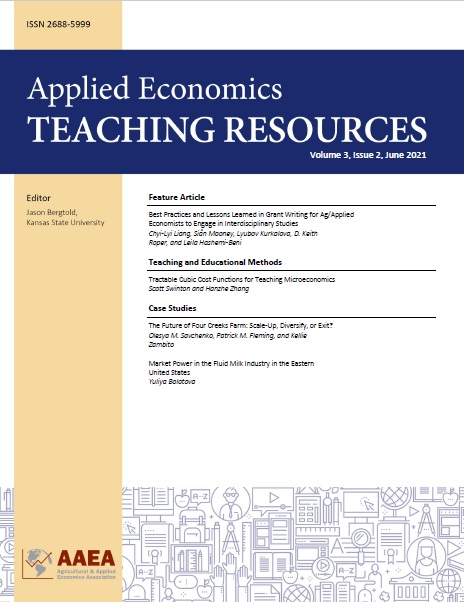Volume 3, Issue 2, June 2021
| View entire issue |
 |
Feature Articles
Chyi-Lyi Liang, Siân Mooney, Lyubov Kurkalova, D. Keith Roper, and Leila Hashemi-Beni
Download PDF
Posted online: May 24, 2021
doi: 10.22004/ag.econ.312078
Abstract: Learning to write successful grant applications takes significant time and effort. This paper presents knowledge, expertise, and strategies from experienced grant applicants and grant officers across several disciplines to support early career scholars and first-time grant writers, with particular guidance for interdisciplinary collaboration. Many Agricultural and Applied Economists are invited to participate in interdisciplinary grant applications. It is important to fully understand the types of projects, nature of collaboration, co-investigators’ characteristics, expected contributions, anticipated benefits, and valuation of collaborative research by one’s peers before initiating new opportunities. Leading and participating in interdisciplinary teams also requires mentorship, patience, professionalism, and excellent communication beyond the scientific merits. This paper shares practical insights to guide scholars through the grant-writing processes beginning with nurturing a mindset, preparing for a consistent work ethic, actively seeking advice, identifying targeted programs, matching a programs’ priorities, a step-by-step framework for team creation and management, effectively managing time and pressure, and transforming failure into success.
Keywords: Early career scholars, grant collaboration, grant writing, interdisciplinary, proposal
Teaching and Educational Methods
Tractable Cubic Cost Functions for Teaching Microeconomics
Scott M. Swinton and Hanzhe Zhang
Download PDF
Posted online: June 2, 2021
Download Supplementary Material
doi: 10.22004/ag.econ.312079
Abstract: Classes in microeconomics typically use cubic cost functions because they can exhibit marginal costs that fall as output increases to some efficient level, and then rise thereafter. Cubic cost functions embody economies of scale, making it easy to illustrate that concept with quadratic average cost curves. However, designing problems with cubic cost functions is harder than it looks because well-behaved functions must meet several mathematical and economic restrictions. Yet as instructors develop more online assignments and exam questions, they face the need to produce varied problems that support the same learning objectives. This article explains the restrictions needed to generate well-behaved cubic cost functions. It proceeds to show how to generate random parameters for well-behaved cubic cost functions for problems that meet common student learning objectives. An associated workbook contains the algorithms described here.
Keywords: Cubic cost function, marginal cost, profit maximization
Case Studies
The Future of Four Creeks Farm: Scale-Up, Diversify, or Exit?
Olesya M. Savchenko, Patrick M. Fleming, and Kellie Zambito
Download PDF
Posted online: June 2, 2021
Request Teaching Notes
doi: 10.22004/ag.econ.312080
Abstract: This decision-scenario case study is designed to be suitable for both online and face-to-face instruction in an undergraduate-level agribusiness, agricultural policy, or business strategy course. The case challenges students to assume the role of decision makers for a struggling family-owned dairy farm to determine whether the farm should scale-up, diversify, or exit the industry. Students will (1) learn about the unique features of the U.S. dairy market and domestic government support policies for dairy farms, (2) understand the challenges facing small family-operated farms, (3) apply strategic management tools to analyze and select the best strategic option to ensure short-term and long-term survival of the farm, and (4) advance critical thinking and decision-making skills. This case study is versatile and can be adapted to a variety of classroom settings. It can also facilitate broader discussions of management decisions facing agricultural businesses operating outside of the dairy industry.
Keywords: Agricultural policy, family-owned dairy farms, government policy, PESTEL analysis, strategic planning, U.S. dairy industry
Market Power in the Fluid Milk Industry in the Eastern United States
Yuliya V. Bolotova
Download PDF
Posted online: May 26, 2021
Request Teaching Notes
doi: 10.22004/ag.econ.312081
Abstract: The motivations for this case study are recent developments in the fluid milk industry in the Eastern United States. These developments reflect the effects of increasing consolidation and concentration as well as emerging competition issues related to the buyer and seller market power of fluid milk processors. Using a marketing margin framework, this case study provides simple contemporary applications of the economic models of the profit-maximizing behavior of firms possessing buyer and seller market power in the fluid milk processing industry. The case study illustrates a marketing margin analysis, as applied to the fluid milk supply chain, including a basic empirical market and price analysis. The intended audiences are undergraduate and graduate students as well as extension and outreach audiences. The case study includes a teaching note with a set of discussion questions and suggested answers. In addition, the teaching note discusses teaching objectives, teaching strategies, and student background knowledge.
Keywords: Antitrust, Capper-Volstead Act, cooperatives, fluid milk industry, Federal Milk Marketing Orders, margins, oligopoly, oligopsony, price-fixing, Sherman Act









